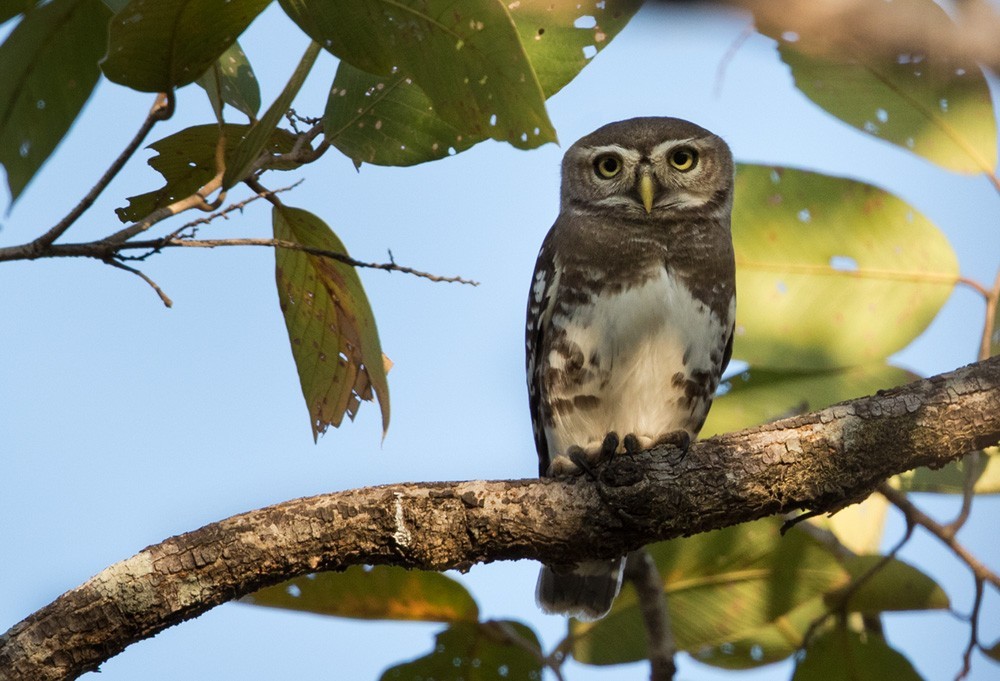Forest Owlet
A species of Heteroglaux Scientific name : Athene blewitti Genus : Heteroglaux
Forest Owlet, A species of Heteroglaux
Botanical name: Athene blewitti
Genus: Heteroglaux
Content
Description General Info
 Photo By Lars Petersson
Photo By Lars Petersson Description
The forest owlet is small (23 cm) and stocky. It is a typical owlet with a rather unspotted crown and heavily banded wings and tail. They have a relatively large skull and beak. Unlike the spotted owlet, the forest owlet has the fewer and fainter spots on the crown and back. The upperparts are dark grey-brown. The upper breast is almost solid brown and the sides are barred with a white central wedge in the lower breast that is sometimes unmarked, especially in males. The primaries are darker and distinct. The wings and tail are banded with white trailing edges. A dark carpal patch on the underwing visible in flight. The facial disc is pale and the eyes are yellow. 
Size
23 cm
Nest Placement
Cavity
Feeding Habits
Forest Owlet mainly hunts during the day and dusk from low perches, favoring mammals like Mus and Suncus species, skinks, and other reptiles as major diet components. It also consumes insects, amphibians, birds, and unidentified prey, indicating a broad carnivorous diet.
Habitat
The forest Owlet is typically found in dry to dense moist deciduous forests, with a preference for those dominated by teak trees. It inhabits areas that border agricultural fields and may occasionally be spotted in streamside mango groves. These birds are commonly situated in the shady middle stratum of the forest during hot weather, and their presence is sometimes noted near villages.
Dite type
Carnivorous
General Info
Feeding Habits
Bird food type
Behavior
The forest owlet typically hunts from perches where it sits still and waits for prey. When perched, it flicks its tail from side to side rapidly and more excitedly when it chases prey. Lizards and skinks constitute nearly 60% of its prey, rodents 15%, birds 2% and the remaining invertebrates and frogs. When nesting, the male hunts and feeds the female at nest, and the female feeds the young. The nestlings fledge after 30–32 days. A study conducted in the forests of Madhya Pradesh revealed that the forest owlet is a generalist predator that consumes a variety of small mammals. The peak courtship season is in January to February during which time they are very responsive to call playback with a mixture of song and territorial calls. The forest owlet appears to be strongly diurnal although not very active after 10 in the morning, often hunting during daytime. On cold winter mornings, it basks on top of tall trees. Filial cannibalism by males has been observed. 
Distribution Area
The forest owlet was recorded in central India, and until 1997 was known from just seven specimens in museums collected in northern Maharashtra, and south-east Madhya Pradesh or western Odisha. The last record until then was based on a specimen claimed from Gujarat in 1914 by Richard Meinertzhagen. Searches in Gujarat had been futile until the species was rediscovered in November 1997 by a group of American ornithologists in the foothills of the Satpura Range, northeast of Bombay. The cause of the earlier failed searches was due to the resubmission of a stolen specimen with the falsification of locality data. The forest owlet was observed in Odisha, Chhattisgarh, Madhya Pradesh, Maharashtra and Gujarat, and at a few locations in Melghat Tiger Reserve in Maharashtra. A survey in 2011 in non-protected areas of Maharashtra and Madhya Pradesh confirmed the presence of the species at two locations. In Maharashtra, a pair was observed (out of 7 pairs in 2004) in Toranmal Reserve Forest. In Madhya Pradesh, six individuals were observed in Khaknar. In Maharashtra, it was also reported to inhabit the forest ranges of Taloda and Khaknaar. All these places in central India harbour dense to open deciduous forests with Tectona grandis, Lagerstroemia parvifolia, Boswellia serrata and Lannea grandis trees. Nest cavities were found at a height of 5.0–8.0 m (16.4–26.2 feet) in trees like Soymida febrifuga. In most areas, the trees were too young and lacking cavities suitable for nesting. An individual was sighted in Tansa Wildlife Sanctuary in the Thane district in 2014. It was reported that human disturbed forests with more clearings within the forests were preferred for foraging. In Toranmal Reserve Forest, the forest owlet utilized areas with open canopy and dense undergrowth. In Gujarat, the forest owlet occurs in Purna Wildlife Sanctuary. 
Species Status
In 2018, the forest owlet was assessed as being endangered, with a population estimated of more than 250 mature individuals. It is threatened by loss and degradation of forests due to illegal logging, encroachment by humans, forest fires and construction of irrigation dams. 

 Photo By Lars Petersson
Photo By Lars Petersson